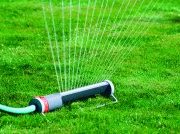Water your lawn only when it’s thirsty, but NOT if there is a watering ban.
Landscape irrigation uses a huge amount of water. The U.S. Environmental Protection Agency estimates that almost one-third of all residential water is used to irrigate our lawns and landscapes. Some experts estimate that more than half of this water used for irrigation is wasted due to evaporation, runoff, or over-watering.
Timing is everything when it comes to watering your lawn efficiently with an automatic or manual sprinkler system. Proper timing is essential for a beautiful and healthy lawn, for saving you time and frustration, and for protecting our water.
Prevent your lawn from becoming a waterholic! Save yourself time, effort, and expense by watering correctly and training your lawn to be more drought-tolerant in the first place. Follow these guidelines to provide your lawn with the water it needs, without threatening the environment, public health or safety.
These tips are applicable to both traditional sprinkler users and those who have automatic irri-
gation systems. If you have an automatic system, we have additional guidelines just for you!
Abide by local watering restrictions, even if you have a private well.
Water is our most precious natural resource. Towns spend large sums of our tax dollars finding sources of water and treating it to drinking quality standards. Our communities require adequate supplies at all times for human consumption and fire protection. In the summer months, this supply can be severely threatened because too much water is being used to irrigate lawns. This is why towns implement “watering bans” to restrict outdoor water use.
Private wells and municipal wells often draw from the same underground aquifers. Do your part to protect your community’s water supply so there is enough for drinking and fire protection. People are more important than lawns – if your town has implemented a watering ban, be sure to comply with all regulations.
Don’t know if there’s a watering restriction in effect?
Call your Town Hall or check our Watering Restrictions page on this website to find out.
Water only between Memorial Day and Labor Day.
In Massachusetts during normal rainfall years, the only time that established lawns usually need to be watered is during the months of June, July, and August. Your lawn doesn’t want extra water in a typical spring or fall because of the cooler weather, shorter days and increased rainfall. If you water when your lawn doesn’t need it, you will cause it to be weaker and susceptible to disease.
Let your lawn tell you when it’s thirsty.
Watering needs can’t be determined by a clock or calendar, but rather by a combination of factors including grass type, soil type, drainage, and exposure to sun or shade. It’s much better for your lawn and the environment if you learn to recognize its need for water by conducting the “Walk Test” (see below).
Use the Walk Test.
Your lawn is thirsty if it can’t stand up straight after being walked on. Test your lawn’s “posture” by taking a walk across your lawn, then turning around to look for your footprints. If you can clearly see your footprints in the lawn for several minutes, the grass is thirsty. If the grass pops up after you walk on it, it doesn’t need water.
Different areas of lawn have different watering needs.
Various zones of your lawn have different drainage, soil types, and exposure to sun and wind, and therefore have different watering needs. Conduct the Walk Test in each area of your yard to determine if they are thirsty, and water accordingly.
Water deeply to prevent “shallow root syndrome.”
Deep watering will encourage grass to have strong, deep roots, whereas brief watering will promote shallow roots that are vulnerable to drought, disease, and traffic damage. Train your lawn to be stronger by soaking the soil to a depth of six inches every time you water (if you have that much soil). Use the Shovel Test (see below) or a soil moisture probe to find out how long it takes.
Use the Shovel Test.
Conduct this simple experiment to determine how long to run your sprinklers to saturate six inches of soil. Run your sprinklers for 20 minutes. Then use a shovel like a lever to open a gap in the soil. You will see that the wet soil is darker than dry soil. If the soil is not damp six inches down, replace the turf and keep watering. Repeat this process every 20 minutes. Record how long it takes for the water to reach six inches, so you will know how long you need to run the sprinklers in this area of your lawn. Different zones will have different watering needs at different times of year, so repeat this test around your yard as the seasons change (ideally around Memorial Day, July 4th and mid-August).
Water your lawn at dawn.
Once you know your lawn is thirsty and you know how much water to use, run your sprinklers at dawn. Watering at daybreak is about 10 times more effective and conserves water. If you are not an early riser or do not have a programmable automatic irrigation system, you can buy an affordable programmable sprinkler timer to attach to your outdoor faucet.
Don’t water if it’s going to rain.
If rain is predicted, don’t waste time and money on irrigation. Too much water is harmful to your lawn and it wastes our water resources. Let Mother Nature do her thing and then wait until your lawn “tells” you it is thirsty when you do the Walk Test.
Water plants, not pavement.
Nothing is more wasteful than a sprinkler that waters the street or sidewalk. For manual systems, adjust the water pressure so the spray doesn’t overshoot the lawn. In difficult-to-reach areas, use a sprinkler head with adjustable nozzles. For automatic systems, make sure sprinkler heads are at least 8 inches from paved areas. Avoid sprinklers that produce a fine mist that easily evaporates and blows off target.
Harvest rainwater with rainbarrels or cisterns.
The average roof will shed over 5,000 gallons of water during the summer months! Rainbarrels and cisterns collect clean rainwater from your roof so you can stockpile it when it’s plentiful and use it later during a drought. Rainbarrels are great for watering small areas by hand and large underground cisterns can even be connected to an automatic irrigation system.
Use in-line drip tubing for beds.
These tube systems can be easily installed in the spring and be hidden with a layer of mulch (the mulch also helps retain the moisture). These systems water the roots rather than the foliage, which is healthier for the plants. These systems are inexpensive and easy to install yourself.





